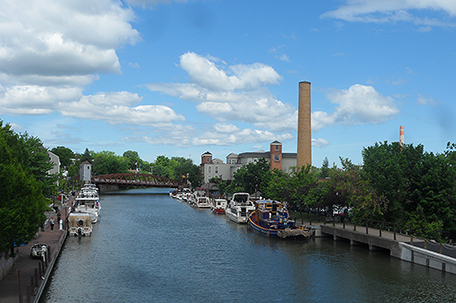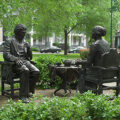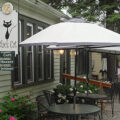
By Renée S. Gordon
“The berths are allotted according to the way bill, the first on the list having his first choice, and in changing boats the old passengers have the preference.” T. Woodcock 1836
New York State is divided into 10 travel regions outside of New York City. Each of these districts is unique geographically and historically and each is filled with sites, attractions and outdoor activities that complement and enhance regional experiences. The Finger Lakes region of New York consists of large urban cities and quaint villages, many of which owe their existence to the more than 500-miles of interconnected canals and waterways of the New York State Canal System. www.iloveny.com
At the time of first European contact Upstate New York had been occupied by Native Americans for more than 12,000-years. The five tribes who greeted the early explorers were members of the Iroquois Confederacy, the Cayuga, Mohawk, Oneida, Onondaga and Seneca. The Iroquois called themselves the Haudenosaunee, “the people of the longhouse.” They were known to the Algonquin as “rattlesnakes” or Iroqu. French trappers added the suffix “ois”. In 1722, the Tuscarora joined the league and it became known as the Six Nations. The Seneca, the largest and westernmost of the tribes were referred to as the “Keepers of the Western Door.”
The Nations lived relatively harmoniously with the earliest settlers because of the lucrative fur trade but their fortunes changed forever when they allied themselves with the British during the American Revolution. In 1799 Gen. George Washington ordered Major Gen. John Sullivan to lead four brigades to totally destroy the homeland of the Confederacy and imprison its occupants. After the war Iroquois land was sold, distributed to soldiers and retained for government use. Four of the counties founded on their former land were named Cayuga, Oneida, Onondaga and Seneca. The Finger Lakes region is situated in what was the heart of the Iroquois territory. www.fingerlakes.org
Ganondagan State Historic Site, located near Rochester, was the location of one of the Seneca’s largest towns, with more than 100 dwellings, during the 17th-century. Visitors to the 500-acre site can follow interpreted self-guided trails, tour a longhouse, attend festivals and participate in scheduled events. The French destroyed the village on July 13, 1687. Ganondagan is New York’s sole historic site devoted to the preservation and presentation of Native American history. www.ganondagan.org
America’s first transportation routes were our waterways, followed by the establishment of roads. In most countries the natural third step is the founding of railroads but in America there was a brief, but extremely significant, return to the use of waterways. George Washington is sometimes considered the father of American canals because he was the first to receive permission to develop a plan for an inland waterway transit system. The American Revolution intervened and New York, in 1791, became the first area to institute waterway improvements.
It quickly became apparent that the settlement of the West was impeded by a lack of the ability to travel safely and transport good cheaply. Gov. De Witt Clinton set out to build a canal that would allow a 364-mile passage from Albany to Buffalo. The US government refused to fund the project but “Clinton’s Ditch” was begun on July 4, 1817 in Rome and completed in 1825 at a cost of $7 million. The Erie Canal was 4-ft. deep and 40-ft. wide. The immediate benefits included, a journey that took less than half the time, the rate for transporting freight dropped 90 percent and New York eclipsed Philadelphia as the nation’s number one seaport. The canal opened in segments as each section was completed. As soon as the canal opened villages sprang up to take advantage of the increased traffic. The hand-dug Erie Canal’s opening ceremony consisted of a flotilla led by Clinton aboard the “Seneca Chief.” He carried two barrels of water drawn from Lake Erie. The water was poured into the Atlantic Ocean in “the Wedding of the Waters.”
From time to time, the Erie Canal was enlarged. But in 1903, it was determined that the system would be best served by adding the Barge Canal. The Barge Canal is made up of the Erie Canal and the Champlain, the Oswego and the Cayuga and Seneca Canals making the system’s total length approximately 800-miles. It was completed in 1918 and has 57 locks and 306 bridges. www.canalny.com
The Erie Canalway National Heritage Corridor was established in 2000. It is a stunning 500-miles from east to west, covers 4,834-sq. miles and is made up of 23 counties. A trip on the canalway is an immersion in the history and geography of the region and provides opportunities to develop a deeper appreciation of the country’s natural landscape. Numerous thematic trails have been created to facilitate touring and maps, guides and interpretive plaques ensure that you take full advantage of the experience. Aside from visiting the historic towns and villages that line the route, visitors can explore on foot and by bike, boat canoe or kayak. Camping, rock climbing and fishing are also available at several locations. www.canals.ny.gov/trails/camping
Family-owned and operated Mid-Lakes Navigation has crafted a very special Erie Canal adventure. The company provides self-skippered, three, four or seven night canal boat rentals. The boats are equipped with a kitchen, bedrooms, family room and lots of deck access. Leasers are given a two hour lesson on piloting the boat and they are ready for the leisurely cruise of a lifetime at 5 mph. The journey includes bridges, aqueducts, primeval landscapes, city panoramas and the experience of going through a lock. This trip is ideal for families, honeymooners and any others romantically inclined. www.midlakesnav.com
For those with less time it is still possible to glide down the canal. Corn Hill Navigation’s “Sam in the City” offers a narrated cruise on the Genesee River to Downtown Rochester. The views are outstanding and the information you gain serves as a wonderful orientation. The Sam Patch is a packet boat named after a famous daredevil of the early 1800s. In 1829, he became the first person to jump the 120-ft. over Niagara Falls. On November 9th of the same year he leapt from the Genesee’s Upper Falls. Four days later, on Friday 13th, Patch scheduled what he advertised as “Sam’s Last Jump” because it was to be his final jump of the season. He took the leap, they found his body four months later frozen in the river. www.samandmary.org
Many of the villages that sprang up along the canal’s path continue to exist as if preserved in amber. Their historic sites and attractions and main streets allow visitors to get a glimpse of the past. Each settlement is singular and helps complete a picture of life during the era of canal transport.
Perinton was cut from the wilderness in 1788 when Nathaniel Gorham and Oliver Phelps purchased more than 6-million acres of fertile land for 2.5-cents per acre. William Walker purchased 36-sq. miles of their acreage and hired surveyors to parcel it into 66 plots of land. One of the surveyors, Glover Perrin, and members of his family moved into the region and founded Perinton. The Village of Fairport was originally a section of Perinton. It boomed after the construction of the canal due to its location on the north-south axis that led directly to the canal.
Fairport is a “front porch community” and its main street, bordering both sides of the canal, is one of the region’s gems. It was named after a visitor who was heard commenting that the village was a truly “fair port.” Anchoring one end of the street is the justifiably famous Fairport Bridge. The irregular decagon bridge has been featured in Ripley’s numerous times. This lift bridge is not level at any point, has no right angles, no two angles that are the same, no square corners and was custom-made. www.village.fairport.ny.us
Fairport’s “Canal Nights” is the largest canal festival of its kind. It showcases the work of 200 artisans, 40 vendors and features a juried art show and local and regional musical entertainment. The annual festival is now in its 37th year. www.fairportcanaldays.com
The April 1788 Phelps and Gorham Purchase also led to settlement in western New York by a group from Pennsylvania. John Jenkins, who had also surveyed the region, purchased a tract of land 6 by 12 miles for the group. By 1790, four families lived in the area.
Palmyra is an award-winning village that has sites related to several “Path Through History” thematic tours. Eighty percent of the buildings in the village were constructed prior to the 18th-century. Once the canal opened Palmyra became known as “the Queen of Canal Towns.” Walking Tour guides are available. www.paththroughhistory.ny.gov
The village was situated on an important Underground Railroad route and fugitives were offered shelter here. Reverend Horace Eaton hid freedom seekers in the belfry of the Western Presbyterian Church along with Quaker Pliny Sexton. Palmyra Historical Museum features displays on village history with an emphasis on its participation in the Underground Railroad. The building dates from 1826 and functioned as a tavern and a hotel. There are 23 themed rooms to explore. www.historicpalmyrany.com
The Alling Coverlet Museum features the largest collection of hand-woven coverlets in the country. The collection consists of coverlets crafted between 1820 and 1860. A gift shop in the museum is the perfect place to purchase a souvenir or unique piece of memorabilia,
It is in a peaceful grove in Palmyra that God the Father and Jesus Christ visited Joseph Smith in 1820. That vision would be the first step in a journey that would result in the birth of The Church of Jesus Christ of Latter-day Saints. There are four extremely significant Mormon historic sites in the area, the Joseph Smith Family Farm complex showcasing the Frame Home, Log Cabin and Sacred Grove, Hill Cumorah and Visitors’ Center and the Book of Mormon Historic Publication Site. The first Book of Mormon was published on Main Street. www.hillcumorah.org
William Phelps General Store and Home is a highlight of a visit to Palmyra. The three story building dates from 1826 and was constructed to house, feed and supply travelers. William Phelps purchased the building in 1868. In 1900, his son Julius acquired the business and ran it for the next 40-years. In 1940, he closed the business, leaving the complete inventory, and did not operate it again. His daughter Sibyl, an actress and spiritualist, lived there until 1976. She had no electricity or running water and never updated the property. Her story is interpreted here as well as that of Palmyra. The museum is known as “where time stands still”. Both the Phelps Store and the History Museum offer guided ghost tours.
The Iroquois took full advantage of the fertile land in their territory. Their diet consisted of fresh food that was healthy and grown in the area, America’s earliest farm to table cuisine. The region continues to be known for its use of fresh produce and vegetables as an important aspect of its dining scene. Each town has unique eateries and dining should be an integral part of your visit.
Richardsons Canal House is situated at historic Bushnell’s Basin, the most beautiful spot on the Erie Canal. It began life as a 1.5-story farmhouse that was purchased in 1818. It was again sold in 1823 and functioned as a tavern and inn for the canal builders. The beautiful Federal building has retained a large amount of interior and exterior trim and is painted in the original colors. The views, the service and the food are spectacular. It has been designated a National Historic Site. www.richardsonscanalhouse.net
Joey B’s in Fairport serves gourmet cuisine in a casual setting. Outdoor dining on the second level provides great canal views as you dine. www.joeybsrestaurant.com
The Genesee Brew House overlooks Rochester’s Historic High Falls. The menu consists of traditional pub fare. On the ground floor of the restaurant visitors can learn the history of beer brewing through interactive exhibits, models and artifacts. There is a beer tasting kiosk, gift shop and mini-brewery. www.geneseebeer.com/brew-house
Fairport Brewery is a classic nanobrewery located inside what was a 1930s Pure Oil Gas Station that is believed to be haunted. Each of their brews has a history and the stories are as interesting as the beer is good. This is the #1 farm brewery in the county and you must experience the beer and the ambiance. www.fairportbrewing.com
The Hilton Garden Inn Rochester is ideally suited to be a base for touring the region. It offers rooms and suites, all the standard amenities and a dining room, in-room dining, business center, fitness room, wireless and pool. Specials are available online. www.rochesterpittsford.hgi.com
I wish you smooth travels!
















Leave a Comment